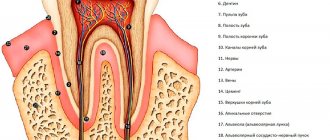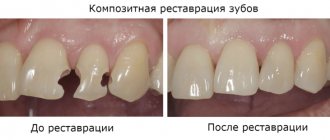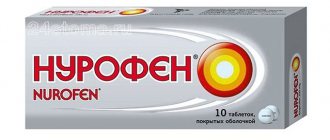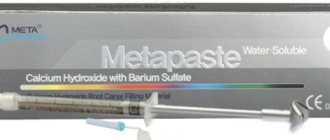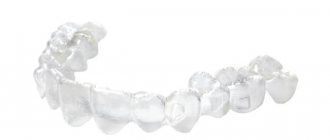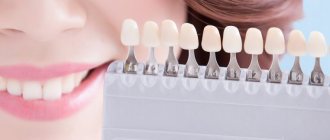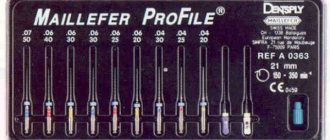Depophoresis is a method of disinfection of damaged internal tooth tissues with copper-calcium hydroxide, which increases the chances of saving complex teeth tenfold. The method is effective for narrow, winding roots. It is also suitable for re-treatment of poorly sealed canals, which cannot be completely unsealed.
Simply put, the procedure destroys pathogenic bacteria in hard-to-reach areas that cannot be treated with conventional instruments during surgical endodontic treatment.
Operating principle
Depophoresis is based on the ability of copper-calcium hydroxide to neutralize pathogenic microflora that has affected the pulp - the neurovascular bundle. Once in the canals, the substance penetrates into the farthest areas and sterilizes them. The process of proteolysis is activated: the “dead” pulp decomposes over time, and the disintegrated tissues are resorbed.
In addition to its disinfectant properties, copper-calcium hydroxide is also believed to stimulate bone formation. It is able to create an alkaline environment in which inflammatory processes cease and conditions for normal bone regeneration are created.
To ensure better passage of the substance through the channels, devices are used that deliver weak current discharges to the tooth. Under the influence of current, copper-calcium hydroxide ions move faster, their trajectory expands, and they spread along the channel.
Reality and myths - “depophoresis” (or - be careful, POISON!)
- What kind of “panacea” is this - depophoresis?
- Now it would not hurt to understand the essence of the issue, and properly - what is depophoresis?
- Well, now to the essence of the conversation. Clinical situation:
- And further:
- In animal cells
- Research
- Determination of copper
- Copper deficiency
- Genetically
- Copper content increases
- Poisoning with copper salts
- Copper and its compounds
- Copper poisoning
- Symptoms
- First aid
- Claimed Impact:
- Scientific research:
- Grade:
- Good luck! But this time, be very careful and careful!
- Oleg Zybin
Scope of application in dentistry
The author of the method, German professor Adolf Knappvost, proposed depophoresis as an alternative to traditional endodontic treatment. According to his research, a positive result from disinfection of canals with copper-calcium hydroxide was observed in 95% of all cases.
However, domestic studies have shown that such high rates cannot be achieved. On the one hand, this difference in research results could be explained by the fact that domestic dentists used other devices instead of the equipment recommended by Knappvost.
On the other hand, living evidence that the method itself is not a universal panacea and does not always work, still speaks for itself. And you can't dispute them.
Yes, this method is undoubtedly effective. But only in combination with classical endodontic measures. For example, the canals are widened with endodontic instruments as far as possible, and then the areas that cannot be penetrated by the instrument are treated with copper-calcium hydroxide.
Prevention of complications
Depophoresis has no side effects. However, the patient must follow a number of rules to avoid the recurrence of pulpitis:
- do not violate the schedule of visits to the dentist,
- undergo preventive examinations once every six months,
- monitor oral hygiene - use high-quality toothpaste, a brush of suitable hardness, rinses, floss.
To prevent pulpitis, caries must be treated in a timely manner. If carious lesions appear, do not delay your visit to the clinic.
Indications
The most important indication is the impossibility of carrying out full endodontic treatment due to too narrow and impassable canals or those whose course is not visible at all. Since it is not possible to “pass” the entire length of the canals with conventional instruments, doctors resort to depophoresis.
Instead of instrumental removal of the affected pulp, it is chemically sterilized with copper-calcium hydroxide.
It is also recommended for patients with previously poorly filled canals in case of re-inflammation of the pulp.
Prescribed for:
- pulpitis;
- chronic periodontitis;
- cyst in the area of the root apex;
- the presence of gangrenous contents and/or dead tissue in the root;
- enlargement of the apical foramen. Nutrients and minerals enter the tooth through this hole.
Not indicated for patients with an allergy to copper, acute periodontitis, or a silver pin in the root. Also not performed on pregnant women.
Tooth affected by pulpitis
Restrictions
There are not many contraindications to dipophoresis. Among them:
- pregnancy;
- acute periodonitis;
- a silver pin installed in the tooth;
- sensitivity to copper alloys.
Stages of the procedure
Before prescribing depophoresis, the doctor assesses the condition of the tooth roots based on an X-ray image. Manual pulp extraction is also performed.
Following actions:
- administration of appropriate anesthesia (taking into account clinical circumstances);
- insertion of a cathode electrode into the dental canal connected to the minus pole on the device (to a depth of 5-8 mm). The positive electrode of the device is localized from the inner surface of the cheek, without touching the teeth;
- Together with the supply of the solution to the channel (copper hydroxide containing calcium is used), an electric field is formed to ensure the movement of ions (current strength is 2 mA). The duration ranges from 5-10 minutes;
- the movement of ions facilitates their passage into all root tubules, ensuring thorough disinfection;
- at the end of the procedure, both electrodes are removed from the oral cavity, and the dental canal is thoroughly washed with 10% calcium hydroxide or distilled water;
- To fill the dental cavity, the same chemical reagent is used, but in the consistency of a paste.
The final filling of the tooth is carried out after two sessions. The interval between them is one to two weeks. As a rule, a repeat procedure is scheduled after 7 days. The course of treatment with depophoresis lasts about a month.
Equipment
The creator of the method, Porofessor Knappvost, guarantees the high efficiency of the technique only if the hardware developed by the German manufacturer Humanchemie (Original II) is used. As for the use of analogues of this device, their effectiveness has not been confirmed.
The German device is the development of the author of the technique himself. With its help, you can accurately calculate the dosage of electric current, as well as adjust the duration of the procedure.
Precautionary measures
- When using the device for depophoresis, it is important to monitor the condition of the mucous membrane of the lips in the area of influence of the electrode. This is necessary in order to prevent overheating of the tissues.
- Direct contact of the electrode and metal crowns in the oral cavity is not allowed.
The Humanchemie kit includes tools for implementing the procedure at various stages:
- to coat the dental nerve, a highly dispersed fraction of calcium hydroxide (in the form of a paste), as well as Kupral (copper calcium hydroxide), are used;
- methylcellulose - used for intermediate root insulation;
- distilled water - needed for flushing channels;
- during treatment and final filling, alkaline cement with a high percentage of copper, called Atatsamita, is used;
The kit also includes a special solution for curing it.
Devices for depophoresis
The device directs weak current charges to the problem tooth and stimulates the spread of copper-calcium hydroxide through the canal.
Adolf Knappvost exclusively used the Original II, manufactured by Humanchemie. This equipment is the only one approved for working according to the original method of Adolf Knappvost.
However, the alternatives are:
- "EndoEst" is also used for electroodontodiagnostics, electrophoresis, narrowing of the apical foramen, etc.;
- AOK 1.0 Modis – portable device with a graphic indicator;
- AOK 1.1 Endo-lux – equipment for electrophoresis, used as an alternative to Original II Humanchemie;
- AOK 2.1 is a compact device for depophoresis and various physiotherapeutic procedures.
Devices for depophoresis
What kind of “panacea” is this - depophoresis?
Without further ado, just by following the publications of recent years, one can really get the impression of some kind of miraculous panacea of the method and the drugs themselves that represent it. However, in fairness, it should be noted that the author of the initially presented technology himself did not go beyond the channels, but paying tribute to our quick minds, one could have guessed that only with what was proposed, our Kulibins could not be stopped. And wherever they push him: he also suffers from caries; and fissure sealant; and milk teeth - quite easily; and the pockets disappear; and treats periodontitis; and copes with the chronicle; and the fistula tightens; and the granulomas disappear somewhere; and the channels need to be opened just a couple of millimeters. Well, it’s just a magical method, and that’s all.
All of the above was, one might say, a lyrical digression.
Now it would not hurt to understand the essence of the issue, and properly - what is depophoresis?
First, let's figure out what exactly the drug used for depophoresis and other proposed procedures consists of. As everyone everywhere and everyone tells us, this is a miracle of nature, or rather the creation of someone’s mind, there is copper-calcium hydroxide. But what kind of substance is this?
Many conversations among the latest dental innovations revolve more and more around a weak alkali - calcium hydroxide Ca(OH)2 and, of course, something like this would be created with it (!), but apparently everyone has already done it, or, in any case, used electric current to influence They've already tried it in the tooth, and they didn't find any miracle.
There is another substance in nature - copper hydroxide Cu(OH)2. This is a very weak base, insoluble in water and has a jelly-like appearance. This substance is obtained by the interaction of a soluble copper salt, for example, copper sulfate CuSO4 with any alkali (NaOH). As a result of the interaction of these two substances, the insoluble base Cu(OH)2 precipitates, and sodium sulfate salt remains in the solution, which is not very important for us at this moment. Now, if we recall some laws that are slightly obscured for many, then it turns out that it is impossible to influence a base insoluble in water with any kind of electric current, i.e. useless. Dissociation reactions, i.e. decomposition of the substance into ions under the influence of electricity will not occur. But the inquisitive mind of the German professor A. Knappvost finally got to the bottom of the “greatest” discovery, and he connected these two substances Ca(OH)2 and Cu(OH)2 together. "Eureka!" - Exclaiming, he put it all in his tooth. And now you and I will try to figure it out - what did he do? And where is “the dog buried”?
Here, in fairness, it should be noted that no matter how bad the resorcinol-pharmaline method, rejected by modern times, is considered, it has not yet driven anyone into the grave. /the meaning of this remark will be clear below/
Description of the procedure
The pulp must first be devitalized, that is, it must stop performing all its functions, including the function of transmitting nerve impulses in response to pain.
Three sessions are required:
- In the first session, the doctor widens the root canal, fills it with copper-calcium hydroxide to a third or two-thirds of its depth and places electrodes in the patient's mouth.
- Then the depophoresis device is turned on, delivering a weak current discharge to the problem tooth. The process ends with the installation of a temporary filling.
- After 8-14 days, at the second session, the procedure is repeated. This is the optimal interval at which the risk of irritation from the application of current is zeroed out.
- At the last third session, the root is filled with atacamite, a special alkaline cement, and the canal is “closed” with a permanent filling.
Nuances of the treatment process
The procedure is minimally invasive, patients do not feel pain. There may only be unpleasant sensations from the application of current.
When working in the frontal area, after each session the oral cavity is thoroughly washed with highly dispersed copper-calcium hydroxide. This is necessary to prevent staining of the enamel.
The result of therapy can be known no earlier than six months later. As a rule, the results are positive and allow you to extend the life of “dead” teeth. After therapy, all patients must be in a dispensary group and regularly observed by a dentist.
Scheme of depopheresis
Depophoresis: indications and contraindications for the procedure
Depophoresis can and should be performed after each depulpation (nerve removal). But this procedure is especially strongly recommended if:
- you have to deal with crooked and hard-to-reach channels, which are very difficult to clean using instrumental means;
- the channels are already sealed and it is not possible to unseal them;
- a cyst was found at the root apex;
- Remnants of dead or gangrenous tissue were found in the canal.
When removing a tooth root using the standard method, there is always a risk of losing a piece of an instrument – a pulp extractor – in the canal. In this case, depophoresis can also help. Having destroyed the organic compounds, it becomes easier to remove the metal piece of the tool. But even if this cannot be done for some reason, being in a sterile environment, the fragment will not cause harm and will not provoke inflammation.
Depophoresis is a harmless procedure, so it can be performed by absolutely everyone, with the exception of only a few categories of patients, namely:
- pregnant women;
- allergy sufferers to copper;
- people suffering from an acute form of periodontitis.
In addition, depophoresis will have to be abandoned if the tooth canal was previously closed with a silver pin.
Advantages
- Suitable for patients who cannot clean the canals in the traditional way: due to obstruction of the canals, as a result of dentist mistakes;
- sterilization ensures minimal risks of re-infection;
- high percentage of positive results. From 60-70 to 95% according to various studies;
- speed, simplicity and painlessness;
- allows you to avoid resection of the root apex in chronic periodontitis.
Below is a list of dentists that successfully practice complex root canal treatment using depophoresis.
Features of the method
The depophoresis technique differs as follows:
- Successful long-term treatment results in 95% of cases;
- The need to carry out only after thorough removal of pulp residues;
- The depophoresis procedure is carried out using a special apparatus;
- Safe and painless manipulation;
- No loss of dentin inside the root during treatment;
- Maintains excellent root stability;
- Minimal risk of damage or perforation;
- Proper preparation of the tooth for filling;
- 100% sterilization;
- Wide range of indications for the procedure;
- Fast manipulation;
- Ability to treat hard-to-reach, curved canals;
- Possibility of carrying out in obliterated canals or in the presence of a broken instrument;
- Reducing the risk of formation of cysts, granulomas;
- Affordable price.
Well, now to the essence of the conversation. Clinical situation:
". I'm in deep despair, but here's the thing. When treating my sister’s teeth, it was discovered that two teeth, one of which was under a metal crown, could not be treated with standard methods, and therefore the doctors decided to use the depophoresis method. In mid-January 2002, depophoresis was completed and the teeth were filled. Everything would be wonderful, but my sister began to notice a pronounced metallic taste in her mouth, sometimes a burning and tingling sensation on her tongue, and strong salivation. These symptoms attracted so much attention that they completely took over her psyche. With her problem, she visited several doctors and had an appointment with a professor. Having examined the oral cavity and discovered two metal crowns, everyone immediately summed up that it was all about them (although the crowns had been in place for 10 years and nothing like this had happened before). I had to remove the crowns, but nothing changed. Now everyone is throwing up their hands. Some hesitantly suggest that this is an allergic reaction to copper ions from depophoresis and this will last a lifetime. I am not an expert, there are many things I don’t understand, for example, how copper ions can get into saliva if they are pumped into the roots of teeth. Before the dental treatment there were no similar symptoms; a taste in the mouth and a burning sensation appeared after the first session. "
And further:
“There are no positive results yet for all the proposed recommendations. Moreover, her general health worsened: dizziness, weakness, fainting (before she did not know what it was). And also, my sister did a blood test the other day, here are some results: Leukocytes - 11 (normal 4-9); Red blood cells - 3.2 (normal 4.5-5.5); Hemoglobin - 98 (normal 120-140)."
When insoluble bases interact with alkalis, water-soluble complex metal salts are formed. By interacting with an electric current, dissociation reactions can already be carried out, i.e. move charged metals in the desired direction, depending on the applied potential.
Thus, when Ca(OH)2 and Cu(OH)2 are combined, we obtain a complex salt - calcium cuprate - CaCu(OH)4. The applied potential of an electric current is capable of decomposing this salt into calcium cations [Ca] +2 and hydroxycuprate anions [Cu(OH)4] -2.
With the proposed method of depophoresis, cuprate anions [Cu(OH)4] -2 are driven into the tooth canal, but since this is not a compound, and it is simply destined by nature to turn into any molecule or molecules, then in the periodontium and in the tooth canals its further transformations into water molecules (H2O) and copper molecules (Cu) occur. It is the presence of copper that, according to the authors’ claims, is supposed to protect the tooth itself and the surrounding tissues from further attacks by bacteria, i.e. - cure him.
